
Wartime Heritage
ASSOCIATION

copyright © Wartime Heritage Association
Website hosting courtesy of Register.com - a web.com company
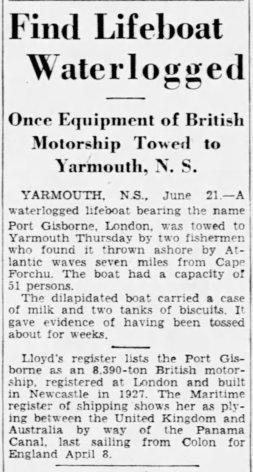
The Derelict Lifeboat
On Thursday, June 20, 1940, two Yarmouth fishermen towed a derelict lifeboat into Yarmouth harbour. The
abandoned and waterlogged boat had been discovered some seven miles from Cape Forchu, apparently having been tossed
about for weeks and driven ashore by heavy Atlantic waves.
The boat had a capacity for fifty-one persons and carried a case of milk and two tanks of biscuits. The water logged
lifeboat bore the name Port Gisborne.
The Maritime Register of shipping reported the Port Gisborne had sailed from the port at Colon, located on the
Atlantic side of the Panama Canal on April 8, 1940 en route to the United Kingdom from Australia having passed through
the Canal.
In the spring of 1940, German U-boats were active off the coast of Nova Scotia and no doubt initial speculation was
the Port Gisborne had become another victim of a U-boats attack.
As early as September 20, 1939, the Commander H. E. Reid of the naval dockyard in Halifax had issued a statement
that fairly reliable reports indicated a submarine may have been operating of the Nova Scotia coast and a Canadian
destroyer had dropped depth charges during a search for the u-boat.
When the auxiliary sloop Triumph arrived in Yarmouth, NS from Boston, Weldong Young a crew member on the
auxiliary sloop Triumph claimed that on Friday, afternoon September 29, 1939 he saw a submarine as his ship was six
miles off the entrance to Yarmouth harbour. The u-boat was five hundred feet astern of the Triumph, its conning tower
and two slim sticks plainly visible and was lying on the surface as the Triumph headed into Yarmouth.
The British cargo motor vessel Port Gisborne of 8,390 tons was built in 1927 by Swan, Hunter & Wigham Richardson
Ltd, Wallsend, Sunderland and owned by Port Line Ltd. The ship’s home port was London, England.
The fate of the Port Gisborne; however, was not as perhaps suspected in June of 1940. It was in October of 1940
that the ship, sailing from Auckland via Halifax en-route to Belfast and Cardiff as part of convoy HX-77 was torpedoed by
U-48 about one hundred and thirteen miles west-south-west of Rockall off Scotland. The ship’s crew totalled 64 and
carried refrigerated and general cargo including 2,479 bales wool and 200 bales skins
On 10:00 pm on October 11, 1940, a single torpedo hit near the bridge forcing the crew to abandon the ship.
The Port Gisborne would normally have had four lifeboats, two on each side of the ship. In October of 1940, had
the missing lifeboat been replaced and did the ship have four lifeboats or was the fourth lifeboat that one brought into
Yarmouth in June?
The crew abandoned ship in three lifeboats. One of the three lifeboats capsized in gale force winds and the
occupants drowned. The master, thirty-six crew members, and one gunner were rescued. The survivors in one lifeboat
were picked up on October 22 by HMS Salvonia and the survivors in another lifeboat on October 24 by the British steam
merchant Alpera.
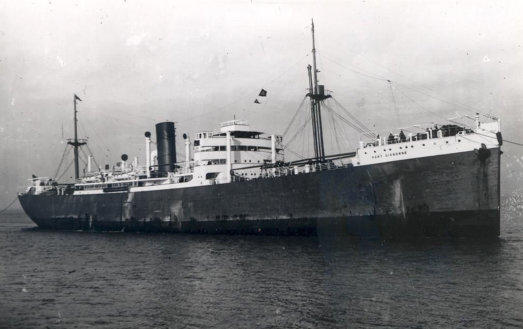
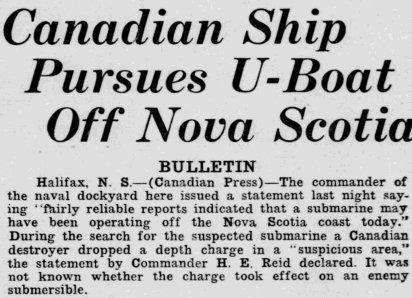
The Derelict Lifeboat
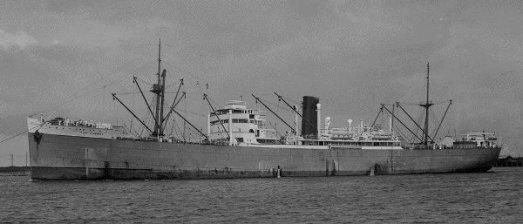
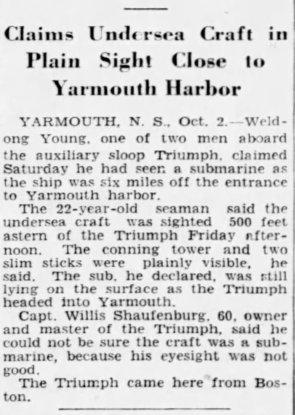



- World War I - Menu
- WWI Stories and Articles
- Photos - Yarmouth Soldiers
- Selection of World War I Songs
- WWI Casualties of Yarmouth, NS
- Those Who Served - Yarmouth, NS
- WWI Casualties Digby Co. NS
- WWI Casualties Shelburne Co. NS
- Merchant Mariners (1915) Yarmouth, NS
- Canadian Forestry Corps - Non Yarmouth Birth/Residence Enlistments
- US Draft Registry - Yarmouth NS Born


- World War II - Menu
- WWII Stories and Articles
- Telegraphist Air Gunners
- WWII Casualties of Nova Scotia
- US Casualties with NS Connection
- Far East/Pacific Casualties with NS Connection
- Merchant Navy Casualties Nova Scotia
- Nova Scotia WWII Casualties Holten Canadian War Cemetery
- D-Day Casualties - Nova Scotia
- CANLOAN Program Casualties - Nova Scotia
- Battle of the Bulge Casualties - Nova Scotia
- WWII Casualties Yarmouth NS
- Yarmouth Casualties - RCAF RAF Canadian Army WWII
- Yarmouth Co., Marrages WWII
- Casualties Non-Born/Residents with Connection to Yarmouth Co., Nova Scotia.
- WWII Casualties Digby Co., NS
- Non-Nova Scotian WWII Casualties Buried in Nova Scotia
- WWII RCAF Casualties Aged 16-18
- Brothers/Sisters Who Served - World War II













